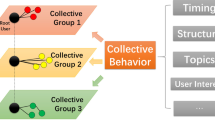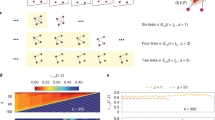Abstract
Collective action propagation, which can be as large as billions of people adopting Facebook or as small as a few researchers citing a paper, exists in various real-life scenarios. Here, we perform a large-scale investigation of collective action propagation with “recurrence” phenomena. We consider actions that propagate in a social network with multiple communities and find the growth in the propagation breadth of collective action can be explained by a simple mathematical model with an analytical solution. We use datasets on the growth of total views of TED and YouTube videos, the prize pool of Dota 2 tournaments, and a total gross of movies to investigate collective action propagation with recurrence phenomena. Experimental results reveal that our model can capture universal features of collective action propagation, validating the idea that collective action propagation with recurrence results from an action being transmitted from communities to communities.





Similar content being viewed by others
References
Wang Z, Andrews MA, Wu Z-X, Wang L, Bauch CT (2015) Coupled disease-behavior dynamics on complex networks: a review. Phys Life Rev 15:1–29
Barabasi A-L (2005) The origin of bursts and heavy tails in human dynamics. Nature 435(7039):207–211
Candia J, González MC, Wang P, Schoenharl T, Madey G, Barabási A-L (2008) Uncovering individual and collective human dynamics from mobile phone records. J Phys A Math Theor 41(22):224015
Zhao Q, Erdogdu MA, He HY, Rajaraman A, Leskovec J (2015) Seismic: a self-exciting point process model for predicting tweet popularity. In: Proceedings of the 21th ACM SIGKDD international conference on knowledge discovery and data mining. ACM, pp 1513–1522
Vázquez A, Oliveira JG, Dezsö Z, Goh K-I, Kondor I, Barabási A-L (2006) Modeling bursts and heavy tails in human dynamics. Phys Rev E 73(3):036127
Althoff T, Jindal P, Leskovec J (2017) Online actions with offline impact: How online social networks influence online and offline user behavior, in: Proceedings of the tenth ACM international conference on web search and data mining, ACM, pp. 537–546
Steinert-Threlkeld ZC, Mocanu D, Vespignani A, Fowler J (2015) Online social networks and offline protest. EPJ Data Sci 4(1):19
Cheng J, Adamic L, Dow PA, Kleinberg JM, Leskovec J (2014) Can cascades be predicted? In: Proceedings of the 23rd international conference on world wide web. ACM, pp 925–936
Yoganarasimhan H (2012) Impact of social network structure on content propagation: a study using Youtube data. Quant Mark Econ 10(1):111–150
Brodersen A, Scellato S, Wattenhofer M (2012) Youtube around the world: geographic popularity of videos. In: Proceedings of the 21st international conference on world wide web. ACM, pp 241–250
Goel S, Anderson A, Hofman J, Watts DJ (2016) The structural virality of online diffusion. Manage Sci 62(1):180–196
Iribarren JL, Moro E (2011) Affinity paths and information diffusion in social networks. Soc Netw 33(2):134–142
Ahmed M, Spagna S, Huici F, Niccolini S (2013) A peek into the future: predicting the evolution of popularity in user generated content. In: Proceedings of the sixth ACM international conference on web search and data mining. ACM, pp 607–616
Myers SA, Leskovec J (2014) The bursty dynamics of the twitter information network. In: Proceedings of the 23rd international conference on world wide web. ACM, pp 913–924
Cheng J, Adamic LA, Kleinberg JM, Leskovec J (2016) Do cascades recur? In: Proceedings of the 25th international conference on world wide web, international world wide web conferences steering committee, pp 671–681
Pastor-Satorras R, Vespignani A (2001) Epidemic spreading in scale-free networks. Phys Rev Lett 86(14):3200
Pastor-Satorras R, Vespignani A (2001) Epidemic dynamics and endemic states in complex networks. Phys Rev E 63(6):066117
Yu H, Xie L, Sanner S et al (2015) The lifecyle of a Youtube video: phases, content and popularity. In: ICWSM, pp 533–542
Eckmann J-P, Moses E, Sergi D (2004) Entropy of dialogues creates coherent structures in e-mail traffic. Proc Natl Acad Sci USA 101(40):14333–14337
Pastor-Satorras R, Vespignani A (2002) Epidemic dynamics in finite size scale-free networks. Phys Rev E 65(3):035108
Boguná M, Pastor-Satorras R, Vespignani A (2003) Absence of epidemic threshold in scale-free networks with degree correlations. Phys Rev Lett 90(2):028701
Moreno Y, Nekovee M, Pacheco AF (2004) Dynamics of rumor spreading in complex networks. Phys Rev E 69(6):066130
Wang Y, Chakrabarti D, Wang C, Faloutsos C (2003) Epidemic spreading in real networks: an eigenvalue viewpoint. In: Proceedings of the 22nd international symposium on reliable distributed systems, 2003. IEEE, pp 25–34
Gross T, D’Lima CJD, Blasius B (2006) Epidemic dynamics on an adaptive network. Phys Rev Lett 96(20):208701
Colizza V, Barrat A, Barthélemy M, Vespignani A (2006) The role of the airline transportation network in the prediction and predictability of global epidemics. Proc Natl Acad Sci USA 103(7):2015–2020
Lee JG, Moon S, Salamatian K (2010) An approach to model and predict the popularity of online contents with explanatory factors. In: 2010 IEEE/WIC/ACM international conference on web intelligence and intelligent agent technology (WI-IAT), vol 1. IEEE, pp 623–630
Zhan C, Situ W, Yeung LF, Tsang PW-M, Yang G (2014) A parameter estimation method for biological systems modelled by ODE/DDE models using spline approximation and differential evolution algorithm. IEEE/ACM Trans Comput Biol Bioinform (TCBB) 11(6):1066–1076
Acknowledgements
This work was supported by National Science Foundation of China (61703355) and Guangzhou Science and Technology Plan Project of China under Grant 201904010224 and 201804010292. Also Thanks are due to Dr. Jing Jing Su for her advice and help.
Author information
Authors and Affiliations
Corresponding author
Ethics declarations
Conflict of interest
We declare that we have no affiliations with or involvement in any organization or entity with any financial interest (such as honoraria; educational grants; participation in speakers’ bureaus; membership, employment, consultancies, stock ownership, or other equity interest, and expert testimony or patent-licensing arrangements), or non-financial interest (such as personal or professional relationships, affiliations, knowledge or beliefs) in the subject matter or materials discussed in this manuscript.
Additional information
Publisher's Note
Springer Nature remains neutral with regard to jurisdictional claims in published maps and institutional affiliations.
Rights and permissions
About this article
Cite this article
Zhan, C., Wu, F., Huang, Z. et al. Analysis of collective action propagation with multiple recurrences. Neural Comput & Applic 32, 13491–13504 (2020). https://doi.org/10.1007/s00521-020-04756-3
Received:
Accepted:
Published:
Issue Date:
DOI: https://doi.org/10.1007/s00521-020-04756-3




